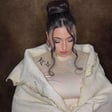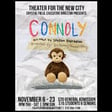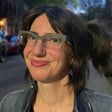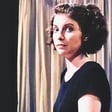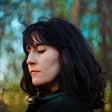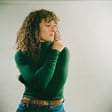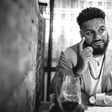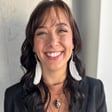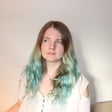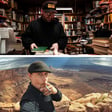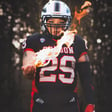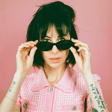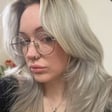Become a Creator today!Start creating today - Share your story with the world!
Start for free
00:00:00
00:00:01

Robyn Tsinnajinnie
Enjoy this wonderful conversation with the amazing painter and artist Robyn Tsinnajinnie. Robyn is a Native artist based in the New Mexico.
Robyn and I spoke about the Southwest, representations of Indigeneity, native shows & art & fashion, philosophy, color and Art School, and so much more!
Her paintings are to be adored and loved.
Find her at sanftmutig_one on Instagram
Transcript
Introduction to Art Slice Podcast
00:00:00
Speaker
When you walk through an art museum, what happens? You see some interesting things, you see some not so interesting things, and if you're like us at all, you're probably a little bit sleepy. Well, grab a cafecito and listen up. It's Art Slice, a palatable serving of art history.
00:00:15
Speaker
We are both artists, so we look at art history through that perspective. We cover the artists you know and those that have been ignored for so many different reasons. We look at the context of the time, we compare it to today. We don't dumb anything down, but, and this is a big but, we like to have a good time, okay? Nos gusta to goof around, all right? We have hungry pantry buns that might startle you. It's a long story. We feed them our materials.
00:00:39
Speaker
Art is just a visual language that is open for anyone to interpret. So if this all sounds good to you, join us on Art Slice, a palatable serving of art history. You are listening to something rather than nothing. Creator and host, Kendalante. Editor and producer, Peter Bauer.
IAIA's Impact on Native Art and Culture
00:01:08
Speaker
opened a lot of doors for me to really connect with myself as a Native person. And the way I expressed that was through making guard and everything. And while being there, it's really nice to see how other young Native people from, you know, the rez and different kind of places coming off and moving into like a big city and being around more people, it helps them break out of just staying home and being on the rez.
00:01:36
Speaker
And there's not a lot of opportunities out there because of course, money problems, family problems, just a lot of stuff people don't talk about. But for them to go to IAIA, it really encourages them and gives them that opportunity to really develop themselves personally and artistically. So it's a win-win all around. Good place to be and to develop and thank you. Yeah.
00:02:03
Speaker
and it's referred to as IAIA for short, Institute of American Indian. Yeah. Yeah. I don't want to make sure they get that down. And, uh, and we're speaking with Robin and, uh, I hadn't even asked you before this is the pronunciation Cinnagini, Robin Cinnagini. Oh my God. Yeah. Cinnagini. Yeah. I wanted to put myself, uh, I wanted to put myself on the spot and I, and I did Robin it is, um,
00:02:28
Speaker
Really, really a pleasure to have you on something rather than nothing podcast and chat with you and listeners before we popped on, I was just telling Robin that over the last few months, I made my first couple trips to New Mexico and Robin's based in Santa Fe, but I had visited Albuquerque and I found it'd be such a wonderful place to visit and it felt
00:02:57
Speaker
I was going to a new place. I was surprised being from Rhode Island in the ocean, thinking about the desert and also the presence of the Pueblo people. And as far as the expression and the art, it was all completely new to me as a lived experience. So really appreciating New Mexico. But Robin, I love your painting. I love your painting.
00:03:25
Speaker
I saw it on Instagram and I had seen you in a couple of publications actually, maybe actually when I was down there in New Mexico, featuring your paintings. I wanted to start with, welcome you on to the show Robin, but also start with, when did you see yourself as an artist?
Robin's Artistic Journey Begins
00:03:49
Speaker
When did you say, hey, this is me, this is what I do?
00:03:55
Speaker
Um, honestly, I pretty much reached that point until I want to say my junior year of college. Um, you know, being a little native kid on the res, I wanted to, you know, help animals and help with healing the livestock around. And, but then like the more I looked into it, I was like, Hmm, maybe this isn't for me. And I would be like, Oh, I want to be a teacher and I'd look into it and it wouldn't work out. But throughout
00:04:24
Speaker
all of my decision making, I was drawing and I was coloring and I was painting. And by the time I got to high school, I went to a primarily white high school. So the only brown people I knew were like a good handful of like 10. And my art teacher was like, Oh, you're really good at this. You should you know, enter these
00:04:49
Speaker
like high school shows and auctions and stuff like that. So I'd be like, okay, I'll do it because it's fun. And from there, she was like, you should go to college and I'd be like, okay. And then I went to college and when I started at IAIA, I was like, maybe this is for me. And what really encouraged me more was other people, like starting to understand what I was doing and just the act of painting and drawing and
00:05:16
Speaker
you know, physically putting down what I see in my mind, I was like, this is probably what I'm supposed to do. And a big part of me figuring out that this is, you know, what I want to do was that when I started really digging into like what I want to create, I started getting mad, I started getting upset, I started getting just so overwhelmed with a lot of stuff going on in my personal life. And of course, just being a short brown lady
00:05:46
Speaker
I was like, I don't want this to bottle up in my head. I don't want to be upset. I don't want to be mad. And so I was like, what if I just make these images?
Art as Personal Expression and Healing
00:05:55
Speaker
And I literally see these images in my brain that I'm like, I should paint it. And once I painted it and got it all done and detailed, I was like, wow, you know, I feel so much better. This really helped me. And I'm like, why am I pushing against and why am I fighting against myself when I can just, you know, delve into myself and
00:06:16
Speaker
And that's how I started creating. And I was like, this is perfect for me, not only helps other people, but at the end of the day, it helps me and I want me to be okay. And I get all these opportunities and I get all these shows and like this podcast, for example. And it makes me more grateful that I am able to do this at this age and that I'm able to have this much publicity and
00:06:43
Speaker
or, I guess, beginning to have this much publicity. Well, you should. I mean, well, I think what you said there is partially, you know, is radical. You're paying attention to yourself and, you know, you state that out there. You're saying, I'd seen,
The Power of Color in Robin's Work
00:06:59
Speaker
not to embarrass you, but I had read a quote that you had and I loved it. I loved it. It was on this point. I want to read it to you. I said, I want my art as a reminder for our young people to see how far we've come.
00:07:12
Speaker
And most importantly, it's for me to heal what's inside of me. And whatever people want to feel about it, that's fine. Now, I don't know if I did your voice the right way or the intonation, but I, um, no, I mean, I just, I, I, I, I love that because you're talking about what you need for yourself. And, um, and, uh, all right. So, uh, there's certainly a lot to talk about that. We're gonna,
00:07:42
Speaker
Um, get further into that, but I wanted to ask you a question like talking right about, um, the painting. I had a great, uh, I had a great conversation, uh, before about, um, powwows and the color and the fluorescence and everything in many of those traditional ones. And I hadn't seen, truly seen the colors and the color contrast until somebody described that. Oh my gosh, it's all there. I saw it more openly.
00:08:11
Speaker
And your use of color is remarkable in jarring. Um, how do you see color? And I'm saying jarring in that the different skin colors and that, that, that would be represented different domestic scenes where the colors are very, uh, they're shifted. How, and you said it comes from your brain. Sorry. So I'm going pretty deep here, but like, how do you use color?
00:08:39
Speaker
And how do you, how do you bring all that out and into your beautiful paintings? Yeah, well, I first started, um, well, when I first started painting, I of course fell in love with color, one specific color. Um, I can't honestly, I kind of, I can't pronounce it. It's like phthalo something blue, but it's this aquamarine blue. And I was just so obsessed with it. I would put it all my stuff and I was like, I wonder if I can like,
00:09:08
Speaker
paint a lady. And I started painting a lady and it came out perfectly. And it was funny because it wasn't necessarily planned, it just fell into what I really was talking about. And the reason why I paint all my ladies different colors is to just take away from people automatically assuming the race of my women. Yeah, like I'm Native, I do want to talk about Native women and other indigenous women, but at the same time, it's not just a
00:09:37
Speaker
you know, indigenous woman problem. And it's all around woman problems, whether you're white, black and native Indian, I don't want to associate or have people assume things because of their skin color. So to take away from that completely, I'm going to make them orange, I'm going to make them blue, I'm going to make them pink. And from there, I just started messing around with different types of colors and how they would make me feel.
00:10:05
Speaker
Um, so for example, if I wanted, um, a painting to feel kind of tense and, um, uh, pretty, yeah, just intense, overwhelming a little bit. I usually tend to use colors like red or orange or yellow, or, and of course, like if you want something to be more somber and sad, I use blue and purples and stuff like that. Um, and I pretty much just, it's like a game of ping pong where I like put one color down.
00:10:35
Speaker
And I'm like, oh, that makes me think about this color. I'm going to put that color down. And I'm like, you know what color would look really nice next to that? I'm going to put that color. So it's just a whole mess, marbles of different colors. And I just like to push that more. So I'm like, who says my desk needs to be brown? I am going to make it blue. Who says my doors are going to be brown and gray? I'm going to make them pink.
00:11:04
Speaker
And so from there, I just, I don't know, I just fell in love with it. I love making colors. And most of the stuff in my paintings do talk about serious subjects and serious situations and unfortunate situations. But I also want people to look at them and get happy and excited because it's a pretty painting with pretty colors. But it's also funny because what I'm talking about and what I'm painting isn't necessarily fun, isn't necessarily good.
00:11:33
Speaker
So it kind of just, I like to just play with people, like get the first inside of being like, Oh, it's nice and happy. And you're like, wait, that's not, that's actually not that like happy. That's actually not good. You know, you gotta, you gotta like the, you got that element in there of switching, switching things around to mess with, mess with folks. And, but you know, the disruption is really important, but I think it's always fascinating to me when you have that disruption,
00:12:02
Speaker
yet you maintain it with the beauty of the composition. Because it can be easy to disrupt folks just by disrupting them. Yeah. Yeah. And a big part of why I create and how I handle most of these hard subjects is through humor and laughter. So it's the same process in my brain. I'm like, oh, this is a really effed up situation. And I'm like, how can I put that on a canvas and I paint it?
00:12:31
Speaker
And I'm like, this is really sad. So I'm gonna put purple here. I'm gonna put pink there. And then I'm like, okay, I feel better. You know, I appreciate the appreciate laughing when it gets to a certain point, I think even like on the sometimes with the show on the philosophy and talking about these grand questions. At the end of it, you just start laughing because it's all kind of
00:12:54
Speaker
Seems inescapable like nonsense is being like what what are we talking about? Nothing something but yet I yet we will Robin yet. We will yeah All right. All right, so tell me let me hit you have another big conceptual question So you're an artist. This is really important for you like in your identity and what you do, but what is what is art like?
Art as a Healing Tool Beyond Creation
00:13:18
Speaker
What do you feel art is?
00:13:21
Speaker
You know what's so funny? This question was one of the questions that haunted me during my freshman year of college because every single class would be like, what is art? Wonderful. All right, so now I get to bring you back to freshman year. Sorry, I didn't know how to do it, like in the sense of bringing it back up. But yeah, so you had to deal with it a lot. So did you come to any conclusion?
00:13:46
Speaker
I have no idea. No, I'm just kidding. It gave me time to develop what I really thought, you know, the question, what is art? But bottom line to me, it's just expression. And for me personally, it's healing. It's a tool for me to really heal myself as a person and as an individual.
00:14:08
Speaker
And I honestly think it's like personal treasure, like everyone, every artist or I guess every person individually and what they create and the art they do create, like secret treasure that everyone has that they create themselves. It's like, you make something and you love it so much. And you fall in love with it. And then it's cool that other people like it too. But people like it so much they want it from you. And you're like,
00:14:33
Speaker
I don't want to give it to you, but at the same time, you're excited that other people relate to it and enjoy it too. But honestly, all around for me, it's just healing. It's a way for me to just tackle every day and tackle big moments in my life that I'm too scared to approach. Yeah. Well, I want to thank you for saying that.
00:14:58
Speaker
Within the podcast, even some recent episodes, I really go deep into or always end up being led there about what art can do for us and like how it can help us heal. I had just recently Susie Deville, who was an author talking about like art practice and morning, good like art practices and just health. And another guest I want to have soon is her name's Asia Frost. She does You Are The Medicine.
00:15:28
Speaker
which is a book about yourself, yourself and healing yourself. And, um, and so I keeps, I keep, when I'm talking our, and we're talking about human experience, it ends up really moving towards like the self and taking care of the self. Um, and it has that, that, that positive, uh, piece for it.
00:15:50
Speaker
Have you had that relationship with art since you started creating? And what I'm asking is, when you started to create things, you recognized being like, I need to do this to help heal and grow and heal. Did you have that feeling?
00:16:07
Speaker
Yeah, I definitely did because when I started painting, I didn't know what I was painting. I was just painting random things and being like, oh, this is pretty. But like I said, as soon as I started realizing that this really helped me internally, I started creating all these paintings around me and all these paintings people like. It really honestly just helps me. And like at the end of the day, I always say I'm not painting this for other people.
00:16:36
Speaker
I'm painting this for me. And it's just nice knowing that other people feel the same way. And I think I will always do that. I don't really go out of my way to show people my stuff. I just go out of my way to show people that I'm healing, that I'm advancing, that I'm doing good.
00:17:02
Speaker
It's always going to be that way. And if I don't, if I don't paint for like a good couple of months, I get so sad. And I didn't even realize that, which goes back to that question where like, were you born an artist or how long have you known you were an artist? I stopped painting for maybe like six to eight months. And I was like, why am I so sad? Like, why am I not enjoying anything? And it finally hit me that I was like, maybe I should paint something.
00:17:30
Speaker
And as soon as I was finished, I was like, I am so happy right now that I've been this past eight months. And I'm like, oh man, oh man, I'm going to have to do this. Yeah, you're going to have to do it. Maybe you're just being like, am I going to have to do this? Tell me about where, you know, I'm up here in Oregon and listeners could be anywhere.
Robin's Success in Galleries and Museums
00:17:51
Speaker
I'm going to ask you about your sites and stuff later, but physically, I just wanted a sense of like physically you have your paintings.
00:17:57
Speaker
Uh, in, in, in, are they displayed in particular? I've seen them listed in like fears and things like that as far as physically displayed art. Yeah. Um, physically, um, right now I have three paintings at K art gallery in Buffalo, Buffalo, New York. Um, and that was actually my first time that my paintings have gone that far East.
00:18:20
Speaker
And yeah, it was really interesting. And one of the big things they had asked me is like, how do you think your art is going to do out here? How do you think people are going to respond to it out here? And honestly, I didn't know. I still don't really know. But it's fun to hear. I feel like as an artist, you're you know, you're going to get criticism, you know, you're going to people are going to I mean, you're putting all your entire self out there. So people are going to, you know, judge you. Yeah. But
00:18:47
Speaker
I don't necessarily care what people think. It's just fun to see the reactions. It's just fun to see how they respond, whether it's bad or good or in between. I'm just like, Oh, cool. Because these are honestly like the thoughts I see in my head. These are the images I see in my head. And I'm like, I'm the only one who can see them. But like when I show them to you, I'm like, what do you think? You know, without knowing me, without knowing anything, what do you think?
00:19:12
Speaker
Um, and recently I had another painting for the Madison museum in Connecticut, um, which would be my fourth painting going out East. Um, and they really enjoyed it. I'm super happy. They did. Um, and I got Buffalo and down in Connecticut as well. That's wonderful. Yeah. Um, I also had one in, uh, a show, the red cloud art show in South Dakota.
00:19:42
Speaker
I guess that's more towards the north. And then other than that, it's just mainly been here in the southwest. Yeah, I was amazed. Yeah, I was I was amazed by the the amount of art and the different types of art. Like I said, when I was down in Albuquerque, everybody was pointing to like Santa Fe and like everybody was talking to Santa Fe. That's your next location. I'm like, I'm going to do it next time. So it's great. It's great to see.
00:20:11
Speaker
you know, all that, all that wonderful art. Um, now I, I think, I think you've answered this question as like, it's related to art, but what, what the role of art is, but I'm actually a little bit different way. I think maybe, you know, the role of art for you is to help, you know, help heal yourself that you've expressed that, but do you have any thoughts about the role of art, like in general, like in, in, in society and what it's supposed to be doing? Like,
00:20:39
Speaker
Is it more important right now in the world like right now or, you know, it's always been kind of the same kind of role.
Correcting Misconceptions Through Art
00:20:48
Speaker
Yeah. No, another big part of like the role of art for me is just teaching, especially being a native American, you know, growing up in schools where they have pictures of us still in like old regalia running around.
00:21:06
Speaker
teepees and hogan's and stuff like that. And that's always been our representation for so long. And that's what also gets me excited about the other young indigenous artists is that we're able to firmly and formally and correctly teach our actual history, our actual culture, our actual families and our actual backgrounds. It gives us a way to teach people the correct information about us.
00:21:32
Speaker
Um, and people will be like, yeah, it's 2022. Of course we know, but there are still people out there who don't believe that native Americans are real or that we still exist. And you're like, that's ridiculous, but it's still out there. So a big part that art can play is for teaching. Um, and of course just release enjoyment and release, giving people the opportunity to, um,
00:22:01
Speaker
to vent properly. And I feel like personally, growing up, we weren't taught to communicate correctly and express ourselves correctly. We were just kind of told to, you know, suck it up and move on. But now it's like we have we have the tools to correctly explain and vent about ourselves and to other people without, you know, triggering an argument or just having people shut down on you.
00:22:31
Speaker
Yeah, do you think some of the, I mean, I would say changes in the media as far as seeing native, you know, created, owned, you know, distributed, well, not distributed necessarily a lot of them, but, you know, reservation dogs and Rutherford Falls and some more movie offerings. Do you think, it feels me, I'm not to speak on it, it feels like a change to me because I'm so glad and to just see
00:22:59
Speaker
all of it. But yeah, do you think it's a real change? Like stuff's really going down right now. How does that feel that way for you? It's I think so. I think that's so exciting, especially with reservation dogs. One of the big thing I love about that show, and it's so funny when I explain it to other people who aren't native, is that every part of that show is something or is what I've grown up with. That's literally the day to day life being a young native person is like.
00:23:27
Speaker
And to me, that's just normal. You know, like the way they talk, the way they act, the stuff they do, the stuff they wear, it's just was normal to me. And growing up as a Native person, I didn't have that association with any of like the childhood shows or teenage shows where, you know, young kids go to school or young kids get into different shenanigans. They were all
00:23:53
Speaker
not native, they weren't brown. So I couldn't connect with that. But with, you know, shows like reservation dogs coming out and more relevant native stuff, I'm like, that's cool. Because like, that's literally what I grew up with. And other people who aren't from the native community are like, I don't understand, like, why would you do that? Or like, I don't understand why they did this, or it's just so weird to them. But to me, I'm like, that's normal. And it's nice knowing that I can be like, yeah, like, that's literally
00:24:22
Speaker
like same. Pretty much. Oh, that's it to see to see that that reflected and I mean, the way that you describe this your personal experience must have been pretty, pretty astounding because it's so unique. Yeah, unique show. Yeah. And like, like I said, growing up, we weren't, we didn't have a lot of stuff that we could relate to. So and especially right now with the native art community and the native
00:24:50
Speaker
fashion community as well is really starting to, you know, go up the lines. Um, and it's, it's even cooler because most of the alumni from the IAIA are starting to have their pieces at like MoMA at the Met. And for me, like fine art would be, you know, old white men making masters of paintings and stuff like that, which is cool. Like, you know, kudos to them, but like,
00:25:17
Speaker
there was no native people who'd done that. So it's like, there's no goal for me to get to, like I'm making my own goals, but it's interesting, but it's also very nice and refreshing. And it also makes me happy for the future generations of young indigenous people because they won't be so afraid to go outside and to do it themselves or to just dream. You know what I mean?
00:25:47
Speaker
Yeah, it's nice. Well, I'm around the education system a lot, and it's the reflective roles of seeing teachers, seeing representations that look like you and that sound like you. But not only from that, the powerful thing is the statement, my teacher thought I was smart, so I was. My teacher thought I was an artist, so I was. And it can work like that. The power of the teacher that
00:26:18
Speaker
by them saying you are, then why not? So yeah, it's a beautiful thing. When, when, when it's there, it's beautiful. And I think we're deficient as a society when we live in ignorance. So I am
00:26:34
Speaker
No, thank you for your comments. I love reservation dogs. I'm wearing a prey shirt by the Predator, the newest Predator movie. And I love, I love to pray. So yeah, being able to do the Predator thing, right? Yeah. It's so awesome. It's so cool. It's so funny because like, I don't know. For me, it's funny because it's like, it's so cool. Like,
00:27:03
Speaker
Yeah, it's so fun seeing Native people do that. And like, whenever I say that around like other people, they're like, well, yeah, of course, like, yeah, it's just a movie. Like, why are you freaking out about it? But it's like, no, I've never seen like young indigenous people play these roles on like TV and for it to be on like all these other accessible viewing stations like Netflix, New Hula and whatever like that.
00:27:28
Speaker
I'm like, it's so cool. Like you, I don't know. You just don't have, like, you don't understand unless you've grown up without not having like actual idols you can look up to. So yeah, it's exciting just to talk to you about it. I mean, I, it's, it's, yeah, it's just exciting to, to, to talk to you about it. That's, that's, that's, that's incredible. And to be able to enjoy, uh, to be, enjoy some of these things and just demand more, I think we just got to keep, um,
00:27:54
Speaker
demanding more. I've talked on the past episode, just like the massive deficiency in the education system and thinking about my experience, you know, growing up East Coast schools and, you know, 80s and stuff like that.
Media Representation and Cultural Impact
00:28:09
Speaker
And there's, there's, there's just really, you know, nothing, there was nothing there now. But I remember learning about Chief Joseph and Nez Perce and
00:28:21
Speaker
that stuck with me. It was like the one thing that I learned and it was, you know, so if there's something there to like to learn about and to see, but really, really enjoy talking about indigenous arts. So Robin, I need to ask you the big question as well and not forget it is why is there something rather than nothing? Why is that?
00:28:52
Speaker
Or you might say, you don't believe it's the case or whatever. No, I, I was this, this, this question really tripped me up. I was thinking about it all day and kept repeating it to myself. Like, how do I answer that? You're welcome or sorry. You're welcome or sorry. Based on your experience. No. Um, why is there something rather than nothing? Because something is it's, you're not alone.
00:29:22
Speaker
you're not alone. There's always something you us as artists, we create energy that we can give to other people. And that's comforting because like I said, you're not alone. And being a young indigenous artist, you tend to feel alone. But it's nice knowing that other people feel the same way. And
00:29:48
Speaker
if that doesn't give you hope, then I don't know, not to sound all like sad, like, um, you know, like drowning and hopelessness, but times can be tough. Yeah. It's a reminder that like, you're not alone. It's rather something than nothing, literally. No, I really appreciate that. Um, absolutely. Just that there is, there is, there is something, um, and that is a good,
00:30:17
Speaker
that can be good enough. That can be wonderful as well. Robin, um, where, where do we find like in the places online and all that type of stuff? We talked about some of the physical locations of your art. Where can we find your, your paintings or buy them or share them on an instant, all that type of stuff. Where do we go? Well, another big part about being an artist is procrastination, which I will stand by. So,
00:30:46
Speaker
My website, by that meaning my website is still in progress. Oh my gosh, everyone's going to hate me when they. We'll get folks an update down the road when it's up. We'll do a big announcement. Don't worry about that. I swear, I swear, I swear it's in there. Um, it's mainly just my Instagram. That's been, um, where I've been communicating with a lot of people and associating all my businesses on there. I'm totally open for people to, you know, DM me and ask questions, whether they want.
00:31:18
Speaker
personal commission pieces. I also sell prints of most of my paintings that I can, you know, talk with whoever wants. Other than that, like I said, the K Art Gallery in Buffalo, New York, they have an article about the paintings I've given them, and a little bit more of the other Indigenous artists who associate with K Art.
00:31:45
Speaker
But other than that, it's just Instagram. For the moment, at least. Well, it's a good way to...
00:31:50
Speaker
Well, it's a good way to connect. I mean, on the show, you know, there's a lot, you know, I, in getting guests and seeing, I mean, when you see a wonderful, fantastic painting and, all right, I adore your paintings, all right. So, but when you see that, you're like, what is somebody up to? What are they doing? And sometimes you look and you're like, wow, they're doing videos as well. Or they haven't painted in five years, but this is what they did during this period. You're just like,
00:32:16
Speaker
go after it. And I think Instagram, you know, visually for whatever, you know, it's great in some ways and probably not in other ways, but at least visually for me, I love to see visual cool vibrant things. So nice, nice spot for that. So right. Definitely. So it's, I'm sorry. No, go ahead. It's also
00:32:41
Speaker
It's also just a little look into my day-to-day life, too. I don't like to exclude a lot of stuff. I like to have people see what I do do day-to-day and, of course, just encourage other people to take the risks and do what they really want to do. And people consider what I'm doing as just staying home and doodling. But to me, I'm like,
00:33:05
Speaker
go home and work. I work all day and I come home and work again and it's all on my will and I'm like, you can do this too. There's nothing wrong with just doing this. Absolutely. Absolutely. Well, it's been fantastic to meet you and of course, seeing your art in your paintings and just honestly,
00:33:28
Speaker
talking about what art means, you know, having a conversation about that is just a really nice experience and I want to thank you. Everybody, Robin Sinagini, a Navajo indigenous American artist, she lives down in
00:33:45
Speaker
CNFA and you can find her stuff on Instagram. Take a look at her paintings and think about them, right? I think they're there to provoke thought. They did with me. So I'm like, I want to see if Robin's down. Like, she sounds like she's the one who wants to provoke thought and then talk. So I give it a shot. Here you are. Yeah, no, that's good. I'm excited. Thank you so much. I'm always happy to talk about
00:34:11
Speaker
um myself and my paintings especially I could go on and on about every little detail about them so I don't think so honestly yeah but thank you so much thanks so much Robin you rock appreciate you thank you I really enjoyed this this is something rather than nothing
